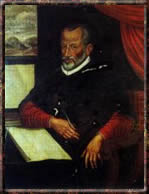| Palestrina's music has long been considered the ideal representation of Counter-Reformation ideals in church music marked as it is by expressive restraint, strictly controlled polyphony, harmonic clarity, elegant melodic writing (owing much to Gregorian chant) and utmost attention to proper accentuation of the words. Palestrina's career began promisingly when his first patron, Cardinal Maria del Monte, Bishop of Palestrina (the composer's birthplace) became Pope Julius III in 1550 and appointed the young composer mstro of the prestigious Cappella Giulia. Through the Pope's influence, Palestrina also joined the Cappella Sistina in 1555 without an audition or the consent of the other singers, and despite his being married, all of which violated the organization's constitution. Later that year, Palestrina was dismissed from his position in the papal chapel by Pope Paul IV, a stern reformer who re-invoked the requirement that papal singers be unmarried. For the next 15 years, the composer worked at several Roman churches before being re-appointed mstro of the Cappella Giulia in 1571, a post he retained until his death. Palestrina's later years were marked by a series of publications in which he systematically refashioned and replaced the sacred repertory in light of the Tridentine liturgical reforms. |
|
 |



